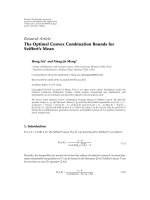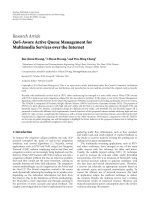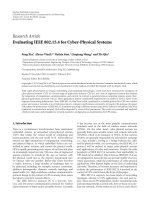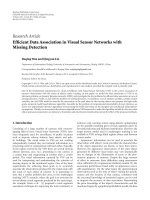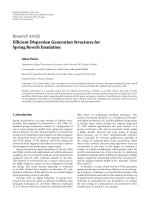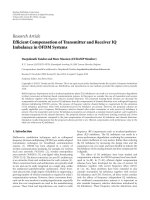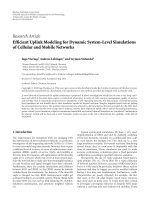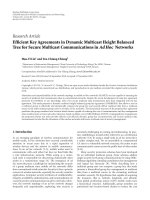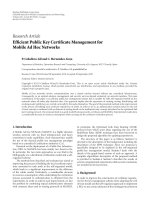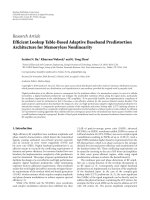Báo cáo hóa học: " Research Article Efficient Dispersion Generation Structures for Spring Reverb Emulation" ppt
Bạn đang xem bản rút gọn của tài liệu. Xem và tải ngay bản đầy đủ của tài liệu tại đây (1.62 MB, 8 trang )
Hindawi Publishing Corporation
EURASIP Journal on Advances in Signal Processing
Volume 2011, Article ID 646134, 8 pages
doi:10.1155/2011/646134
Research Article
Efficient Dispersion Generation Structures for
Spring Reverb Emulation
Julian Parker
Department of Signal Processing and Acoustics, Aalto University, 02150 Espoo, Finland
Correspondence should be addressed to Julian Parker, julian.parker@tkk.fi
Received 22 September 2010; Revised 21 December 2010; Accepted 9 February 2011
Academic Editor: Federico Fontana
Copyright © 2011 Julian Parker. This is an open access article distributed under the Creative Commons Attribution License, which
permits unrestricted use, distribution, and reproduction in any medium, provided the original work is properly cited.
Spring reverberation is a sonically unique form of artificial reverberation, desirable as an effect distinct from that of more
conventional reverberation. Recent work has introduced a parametric model of spring reverberation based on long chains of all-
pass filters. Such chains can be computationally expensive. In this paper, we propose a number of modifications to these structures,
via the application of multirate and multiband methods. These changes reduce the computational complexity of the structure to
one third of its original cost and make the effect more suitable for real-time applications.
1. Introduction
Spring reverberation is an early method of artificial rever-
beration, first proposed by Hammond in the 1940s [1].
Standard spring reverberators consist of a configuration of
one or more springs in parallel. Each spring has magnetic
beads attached to its ends. Torsional motion is excited in the
spring wire by applying an input signal to an electromagnetic
coil, which then exerts a force on the magnetic bead at one
end of the spring. At the opposite end of the spring, the
movement of the magnetic bead induces a current in another
electromagnetic coil, producing an output signal.
Spring reverberation gained popularity in the late 1950s
and 1960s, in both studio applications and within instrument
amplifiers, due to its relatively small size and inexpensiveness
compared with the other methods available at the time.
This method of reverberation has a unique sound, due to
the highly dispersive nature of wave propagation through
the spring. This sound became important to musicians
as an effect distinct from standard reverberation [2], and,
therefore, replication of this effect for use in a modern digital
signal processing context is desirable.
Previous work on digital replication of spring rever-
beration has focussed mainly on physical modelling, using
waveguide techniques [3] and finite difference techniques
[2, 4, 5]. Recent work has introduced a spring reverberation
effect based on nonphysical modeling techniques. This
model is structured similarly to a conventional Schroeder-
style digital reverberator [6], with the addition of long chains
of all-pass filters which produce the required dispersion
[7]. This method approximates the main features of a
spring reverberator well, and its parametric nature makes
it highly flexible. However, the large chains of all-pass
filters necessary can be more computationally expensive
than is desirable for real-time applications, especially in
the context of computer-based music production, where
many audio synthesis and processing algorithms must run
concurrently in real time. In this paper, we introduce a
number of possible modifications which greatly reduce the
overall computational cost of this structure, by application
of multirate methods and by splitting the signal into multiple
bands to exploit the relationship between the “stretch factor”
and the impulse-response length of the “stretched” all-pass
filters used [8].
In Section 2, we give a brief overview of the parametric
spring reverberation model whose efficiency we are attempt-
ing to improve. In Section 3, we describe the principles of the
multiband method used and how this method and others can
be applied to the spring reverberation structure to produce a
reduction in computational cost. In Section 4,weevaluate
the total savings in computational cost provided by these
modifications. In Section 5,weconclude.
2 EURASIP Journal on Advances in Signal Processing
2. Parametric Spring Reverberation with
All-Pass Filters
The property of spring reverberation that gives it its special
sound is its dispersivity—the way different frequencies take
differing amounts of time to traverse the spring from one
end to the other. In fact, the relationship between frequency
and traversal time is not one-to-one, it is one-to-many.
A particular frequency may travel through the spring at a
number of different speeds simultaneously [4].
Like any reverberant system, the impulse response of a
spring is made up of a series of echoes of the input impulse.
However,thisseriesofechoeshasanumberofqualities
which distinguish it from, for example, a reverberant room.
Firstly, the series of echoes produced by the spring is
relatively regular and equally spaced, in contrast to the sparse
set of irregularly spaced early reflections followed by a later
diffuse tail which is exhibited by a room [6]. Secondly,
individual echoes are altered more drastically by the system
than is usual in a reverberant space—in addition to the usual
attenuation and change in frequency content of the echoes,
the dispersivity of the spring bends the echoed impulses into
chirps.
Broadly speaking, the impulse response of a spring can
be thought of as two series of these dispersive echoes or
chirps. The main series of chirps is present only below a
certain frequency, referred to as the transition frequency, f
C
.
This frequency is dictated by the geometry of the spring,
and its material properties [4]. The group delay has a
maximum at f
C
. The second set of echoes is present over
the whole audio band, but at much lower amplitudes than
the lower-frequency echoes. This set of chirped echoes has
its maximum group delay at low frequencies, decreasing as
frequency increases.
The chirped echoes produced by a spring reverberation
unit can be modelled in a number of ways. V
¨
alim
¨
aki et al. [7]
propose the use of long cascades of all-pass filters, known as
“spectral delay” filters [8]. In this case, the starting point is a
first-order all-pass filter, whose transfer function is given by
A
(
z
)
=
a + z
−1
1+az
−1
,(1)
where a is the all-pass filter coefficient. We then replace the
unit delay within the filter with a longer delay element, giving
the following equation:
H
single
(
z
)
= A
z
k
=
a + z
−k
1+az
−k
. (2)
The length of this delay line, k, is known as the “stretch
factor”. This stretching process aliases the curve describ-
ing the relationship between group-delay and frequency,
squashing it and reflecting it around a number of points
and hence resulting in several peaks of maximum group-
delay. The stretching process also increases the overall group-
delay of the structure multiplicatively, hence “stretching”
the chirp which describes the filter’s impulse response. This
structure can also be extended to allow noninteger values
C
hf
C
lf
o
dry
o
high
o
low
+
Figure 1: Block diagram showing high-level structure of the
parametric spring reverberation model [7].
of k by replacing one of the internal unit delays with an
interpolating first-order all-pass filter [7]. Finally, many of
these stretched all-pass filters are cascaded, lengthening the
chirp even further. This cascaded structure is given by
H
cascade
(
z
)
= A
M
z
k
=
a + z
−k
1+az
−k
M
,
(3)
where M is the number of cascaded sections.
V
¨
alim
¨
aki et al. [7] propose a simple algorithm to produce
the spring reverberation effect. It consists of two parallel
delay lines with feedback, with an appropriately designed
spectral delay filter placed within each feedback loop to
produce the dispersion required. One feedback structure
produces the chirped echo sequence below f
C
.Thisstructure
is referred to as C
lf
. This feedback structure is followed by
a lowpass filter, in order to suppress any behaviour above
f
C
. The other feedback structure produces the wide-band
chirped echoes and is referred to as C
hf
.TheparallelC
lf
and C
hf
structures are shown in Figure 1 whilst their internal
structures are shown in Figures 2 and 3,respectively.The
output of these structures is then mixed with a user-variable
amount of the “dry” input signal to produce the final output
of the effect.
V
¨
alim
¨
aki et al. [7] also include other features in the
design of the effect, including random modulation of the
delay lines, cross-coupling of the two feedback structures
and an equalisation filter, in order to reproduce other
qualities of the spring reverberator’s sound. These features
are computationally light (on the order of 10 multiplications
per sample period) compared to the dispersion generating
all-pass filters, and, therefore, are ignored for the purpose of
this work.
3. Efficient Dispersion Generating Structures
3.1. Chirp Straightening. In this section we describe a
method for reducing the number of all-pass filters necessary
to model the dispersion required by the spring reverberation
effect. The genesis of this method lies in a basic property
of the “stretched” all-pass filters used [8]—the strong
dependence of the total group-delay provided by one all-
pass section on its stretch factor, k. If we maximize the
stretch factor of the filters used, we can reduce the number of
cascaded sections needed to produce the required dispersion,
and, hence, reduce the computational load. The problem
then becomes finding a way of increasing the stretch factor of
EURASIP Journal on Advances in Signal Processing 3
g
lf
Delay line
A
M
low
(z
k
)
H
low
(z)
+
−
Figure 2: Simplified block diagram showing C
lf
structure.
g
hf
Delay line
A
M
low
(z)+
−
Figure 3: Simplified block diagram showing C
hf
structure.
the filter whilst still producing a relationship between group-
delay and frequency of approximately the right form.
In the case of the C
lf
structure, it can be seen intuitively
that if the stretch factor of the filters used is doubled and the
all-pass coefficient changed from positive to negative, the cas-
cade maintains a maximum group delay at the appropriate
frequency, but also gains an additional maximum of group
delay at DC. Shown in Figure 4(a) is the chirp before the
coefficient negation and doubling of the stretch factor and,
in Figure 4(b), the chirp produced after these alterations.
Importantly, the modified structure has a minimum of group
delay at a frequency below which the unmodified structure
also has a very low group-delay. One can, therefore, produce
a hybrid structure which approximates the unmodified chirp
by splitting the signal with a crossover filter, presenting the
upper band to the dispersion-generating all-pass chain and
allowing the lower band to pass unfiltered.
Due to the feedback present in the system, a Linkwitz-
Riley crossover filter [9] seems desirable due to its overall
all-pass frequency response once the bands are recombined.
The crossover frequency is chosen as the point of minimum
group-delay of the all-pass chain, which is at half the chosen
transition frequency f
C
. The crossover order must be fairly
high to suppress any cross-talk between the bands. An 8th-
order crossover, where each crossover filter is produced by
cascading two 4th-order Butterworth filters, proves to be
a good compromise between steepness and the problems
introduced by moving to a higher-order filter, such as extra
group-delay around the crossover point.
In order to time-align the two bands, it is necessary to
insert a delay line in the undispersed path, matched to the
group-delay of the dispersion-generating all-pass chain at the
crossover frequency. The group-delay of the all-pass chain
can be calculated using the following expression [8]:
D
= kM
1 −a
2
1+2a cos
(
ωk
)
+ a
2
,
(4)
where D is the total delay in samples, k is the stretch factor,
M is the number of cascaded all-pass stages, a is the all-pass
filter coefficient, and ω is the angular frequency.
A fractional delay is necessary for precise time alignment
of the two bands. A good fit for this purpose is a standard all-
pass interpolated fractional delay line. However, in contrast
to usual applications where a specific fractional delay time
at DC is required, we need to match a particular fractional
delay at an arbitrary frequency. The equation specifying the
group-delay of a first-order all-pass filter is
D
=
1 −a
2
1+2a cos
(
ω
)
+ a
2
,
(5)
where D is the total delay in samples, a is the all-pass filter
coefficient, and ω is the angular frequency. We can solve this
equation with respect to a, producing the following equation:
a
=
−
D cos
(
ω
)
±
1 −D
2
+ D
2
cos
(
ω
)
2
1+D
.
(6)
This expression allows us to design a first-order all-pass
filter that possesses a specific fractional delay at a specific
frequency. At angular frequencies of 0 and π, corresponding
to DC and the Nyquist frequency, respectively, this equation
collapses to give only one solution. At other arbitrary
frequencies between these two values, two solutions are
produced, one corresponding to a negative value of a and
onetoapositivevalueofa. In the case of the C
lf
structure,
it is more appropriate to use the solution with a positive a,
as this places the maximum of group-delay within the the
region above the crossover frequency, where the fractional
delay line is receiving little or no signal.
The response of this two-band chirp generation structure
including the time alignment is shown in Figure 4(c).Ascan
be seen, the group-delay of the modified structure is very
similar to that of the unmodified structure, albeit with a
slightly steeper transition between low and high group delay,
and obviously no dispersion within the lower half. A generic
block diagram of this two-band chirp generation structure
is show in Figure 5. We refer to this modification as “chirp
straightening”, as it is based on discarding an area of the
chirp where dispersion is low and replacing it with a straight
impulse.
Another drawback of this structure compared to the
original structure is a very small notch in the frequency
response at the crossover frequency. This is very minimal for
early chirps, but visible once echoes have cycled through the
system a few times. This notch appears because the time-
alignment delay line only matches the phase between the
bands at exactly the crossover frequency. At frequencies close
to the crossover but offset towards the dispersive region, the
phases of the bands differ and cancellation occurs. The effect
is relatively minor, but could be further suppressed by the use
of a higher-order time-aligning all-pass filter to match both
the group-delay of the upper band and its derivative(s).
3.2. Modifying C
lf
. The structure C
lf
canbemadelesscom-
putationally intensive via the chirp-straightening method
described in Section 3.1. However, this is not the only saving
4 EURASIP Journal on Advances in Signal Processing
50250
Time (ms)
0
1
2
3
4
5
6
7
Frequency (kHz)
(a)
50250
Time (ms)
0
1
2
3
4
5
6
7
Frequency (kHz)
(b)
50250
Time (ms)
0
1
2
3
4
5
6
7
Frequency (kHz)
(c)
Figure 4: Spectrograms showing (a) a single C
lf
chirp, produced by the original structure, (b) the modified chirp, and (c) the modified chirp
after straightening of the bottom half. All chirps have been low-pass filtered to remove information above the desired f
C
.
possible. C
lf
is intended to only produce sound at frequencies
below the transition frequency f
C
, and, therefore, it can be
run at a lower sample rate than the rest of the structure
without degradation of sound quality. To avoid the overhead
associated with an arbitrary change in sampling rate, it is
best to downsample to a rate which is an integer division of
the main sampling rate, rather than downsampling to f
C
.An
f
C
ofabove5kHzisrarelyseeninrealspringreverberators,
and, therefore, it makes sense to run the C
lf
structure at f
s
/4,
where f
s
is the master sampling rate, assuming a standard
audio sampling rate of 44.1 kHz.
The downsampling and upsampling stages require an
antialiasing and reconstruction filter, respectively. These
should be kept relatively efficient in order to preserve the
gains produced by the reduction in sampling rate. We already
have an elliptic lowpass filter H
low
at the output of the
C
lf
structure, whose cutoff is set below the new Nyquist
frequency. We can, therefore, also use this filter to perform
the reconstruction, at no extra computational cost, albeit
losing the potential savings of running the elliptic filter at
the lower sample rate. For the antialiasing filter, we take a
standard approach and design a Type 1 Chebyshev lowpass
filter [10] of order 10, with moderate (2 dB) pass-band
ripple allowed. The cutoff frequency is set to be just below
the Nyquist frequency of the downsampled structure. The
application of multirate methods [11] could result in an
antialiasing filter design with superior characteristics and
lesser computational cost, but such an approach is beyond
the scope of this paper.
A spectrogram of the impulse response of the modified
C
lf
structure can be seen in Figure 6,aswellastheequivalent
impulse response produced by the unmodified structure
Linkwitz-Riley
crossover
Delay line
Dispersion filter
+
Figure 5: Block diagram showing generic structure used to produce
straightened chirps.
for comparison. A block diagram describing the modified
C
lf
structure is given in Figure 7. Ta bl e 1 shows how the
parameters of the original all-pass chain are changed by the
straightening process, and to account for the downsampling
of the structure.
3.3. Modifying C
hf
. The structure C
hf
canbemademore
efficient by applying the methods described in Section 3.1
in a slightly modified form. The wide-band chirped echoes
produced by C
hf
have a point of maximum group-delay at
DC, and little dispersion above 10 kHz. Therefore, no change
in all-pass coefficientisneededinthiscase.Wecansimply
increase the stretch factor to k
= 2, hence doubling the
amount of dispersion produced by each cascaded stage. This
produces another maximum in group-delay at the Nyquist
frequency, with the minimum group delay present at f
s
/4.
We, therefore, place the crossover at this frequency, and
allow only the lower band to be processed through the all-
pass filter cascade. The dispersion is minimal in a large
range around the crossover frequency, and, therefore, the
order of the Linkwitz-Riley crossover can be reduced to 4,
consisting of two cascaded second-order Butterworth filters
for each band, without producing any adverse effects. The
EURASIP Journal on Advances in Signal Processing 5
0.50.40.30.20.10
Time (s)
0
1
2
3
4
5
6
7
Frequency (kHz)
(a) C
lf
chirp sequence
0.50.40.30.20.10
Time (s)
0
1
2
3
4
5
6
7
Frequency (kHz)
(b) C
lf
chirp sequence after modifications
0.50.40.30.20.10
Time (s)
0
5
10
15
20
Frequency (kHz)
(c) C
hf
chirp sequence
0.50.40.30.20.10
Time (s)
0
5
10
15
20
Frequency (kHz)
(d) C
hf
chirp sequence after modifications
Figure 6: Spectrograms showing chirp sequences produced by the original and modified structures.
Decimation
block
Linkwitz-Riley
crossover
Delay line
Low
High
g
lf
+
−
+
A
M
low
low
(z
k
)
z
−D
low
×4
interpolation
H
low
(z)
Figure 7: Block diagram showing C
lf
with modifications.
time-alignment fractional delay is designed according to
the method described in Section 3.1. However, this time
the negative a solution is chosen in order to place the
maximum of group delay of the interpolating filter below
the crossover frequency. A block diagram describing the
modified C
hf
structure is given in Figure 8. Ta bl e 1 shows
how the parameters of the original all-pass chain are changed
by the straightening process.
4. Results
In order to properly evaluate the savings in computational
cost which the modifications described above provide, it
is necessary to quantify the computational cost in some
way. We do this by counting the number of multiplications
required by the effect before and after implementation of the
suggested modifications. In order to count the number of
6 EURASIP Journal on Advances in Signal Processing
Table 1: Modifications required to the parameter values of the all-pass cascades in structures C
lf
and C
hf
, after chirp straightening and
downsampling.
Structure Parameter Original After straightening After downsampling
C
lf
Stretch factor k 2kk/2
All-pass chain coefficient a
lf
−a
lf
−a
lf
Chain length M
low
M
low
/2 M
low
/2
C
hf
Stretch factor 1 2 n/a
All-pass chain coefficient a
hf
a
hf
n/a
Chain length M
high
M
high
/2n/a
Linkwitz-Riley
crossover
Delay line
Low
High
g
hf
+
−
+
A
M
high
high
(z)
z
−D
high
Figure 8: Block diagram showing C
hf
with modifications.
multiplications necessary, we must make some assumptions
about the implementation of the structures involved. Firstly,
we assume that all filters are implemented in direct form II
(DFII), and hence require 2(N +1) multiplications, where N
is the order of the filter in question. Some of the filters in the
effect structure could potentially be implemented in a more
efficient manner, particularly the all-pass filters [12]. How-
ever, assuming the use of DFII provides us with a reasonable
baseline estimate of complexity in order to show the savings
produced by the changes. Tab le 2 shows a comparison of
the number of multiplications, broken down into sections of
the structure, before and after the modifications are applied.
Values shown are given as multiplications per sample period
at full f
s
, therefore, the sections which are undersampled can
produce a fractional number of operations. In this example,
we assume initial all-pass chain lengths before modification
of M
low
= 100 and M
high
= 200, as used by V
¨
alim
¨
aki et al.
[7]. According to this technique of evaluating the savings, the
new structure possesses around one third of the computa-
tional complexity of the unmodified structure.
This evaluation of the efficiency of the spring reverbera-
tion structure raises an interesting question. In its modified
state, the majority of the computational cost of the effect
is produced by the C
hf
structure. Given that the wide-band
chirped echo sequence that this structure replicates is less
important perceptually in real spring reverberation units
due to its low amplitude (generally at least 30 dB below the
other chirp sequence) [4], it may be acceptable to discard it
completely and use only C
lf
. This would produce an even
lower cost spring reverberation effect at the cost of some
realism.
Figure 9 shows spectrograms of the impulse response of
the complete parametric spring reverb model including the
additional features described in [7], such as random delay
line modulation and a series of “pre-echoes” before each of
Table 2: Multiplications required (per sample period at full f
s
)for
effect structure, broken into sections and shown with and without
the suggested modifications.
Section Element Original mult. Efficient mult.
C
lf
A
M
low
low
600 75
g
lf
10.25
H
low
18 18
L-R crossover 0 10
Time-aligning delay 0 2
Antialiasing filter 0 20
C
hf
A
M
high
high
400 200
g
hf
11
L-R crossover 0 24
Time-aligning delay 0 2
General Output mix gains 3 3
Total 1023 355.25
the main low-frequency chirps. Note that the downsampling
of the C
lf
structure means that care must be taken over
the interpolation method used for the random delay line
modulation, in order to avoid unwanted filtering of the
signal. We, therefore, use low-order Lagrange interpolation
instead of the linear interpolation originally suggested by
V
¨
alim
¨
aki et al. [7]. The response produced by both the
modified and original C
lf
and C
hf
structures are shown. The
parameters of the effect are chosen as discussed in [7]and
are of very similar value as the examples given in that work.
The modified and unmodified structures appear to produce
an output which is in reasonably close agreement, albeit
with some changes in frequency-dependent reverberation
time, especially around the crossover frequency in C
lf
.
Informal listening tests show that audibly the modified and
unmodified model are reasonably similar. The notch in
reverberation time introduced by the crossover is not easily
audible. The straightening of the lowest part of the C
lf
chirps
is audible as a slight hardness of the echoes compared to the
original structure, especially when presented with percussive
material. However, the effect is not major, especially when
listening to the effect applied to musical signals rather than
examining the impulse response in isolation. If desired, the
modified effect can be tweaked further in an attempt to more
EURASIP Journal on Advances in Signal Processing 7
10.80.60.40.20
Time (s)
0
2
4
6
8
10
Frequency (kHz)
(a) Complete model before modifications
10.80.60.40.20
Time (s)
0
2
4
6
8
10
Frequency (kHz)
(b) Complete model after modifications
10.80.60.40.20
Time (s)
0
2
4
6
8
10
Frequency (kHz)
(c) Complete model after modifications and lowering of C
lf
all-pass
coefficient
Figure 9: Spectrograms of the impulse response of the complete spring reverberation effect, before and after the efficiency modifications are
implemented.
closely match the original effect. For example, the coefficient
of the dispersion-generating all-pass filters used in C
lf
may
be lowered slightly, in order to match the original chirp
shape a little more closely. The result of this alteration is
shown in Figure 9(c). Unfortunately, this tweak comes at the
cost of reducing the overall dispersion of the structure and
exacerbating the notch in the frequency response around
the crossover frequency, and, therefore, its appropriateness
depends on the relative subjective importance of these quali-
ties.
Sound examples can be obtained at the website associated
with this work [13], and present the impulse responses of the
original and modified structures, the impulse responses of
the original and modified C
lf
structures alone, and examples
of the original and modified effect applied to a short vocal
passage and a short synthesized drum loop.
5. Conclusion
In this work, we examined a simplified version of the para-
metric spring reverberation structure proposed by V
¨
alim
¨
aki
et al. [7]andproposedanumberofchangeswhichgreatly
reduce its computational cost. These modifications are
mainly based on splitting the signal into frequency bands
which require dispersion and frequency bands which do not.
Wethendesignmoreefficient dispersion generation struc-
tures for the bands which do require dispersion, reducing
the overall computational complexity. We also exploit the
limited bandwidth of parts of the structure to apply multirate
methods. The result is a structure that produces a similar
spring-reverberation effect at approximately one third of the
computational cost of the original structure proposed by
V
¨
alim
¨
aki et al.
8 EURASIP Journal on Advances in Signal Processing
Acknowledgments
Many thanks are due to Vesa V
¨
alim
¨
aki for proofreading and
guidance, and to the anonymous reviewers for improving
this paper through their many useful comments. This paper
was supported by the Academy of Finland (Project no.
122815).
References
[1] L. Hammond, “Electrical musical instrument,” US Patent no.
2230836, February 1941.
[2] J. Parker, Spring reverberation: a finite difference approach,M.S.
thesis, University of Edinburgh, 2008.
[3] J. S. Abel, D. P. Berners, S. Costello, and J. O. Smith III, “Spring
reverbemulation using dispersive allpass filters in a waveguide
structure,” in Proceedings of the 121st Convention of the AES,
San Francisco, Calif, USA, 2006.
[4] J. Parker and S. Bilbao, “Spring reverberation: a physical per-
spective,” in Proceedings of the 12th International Conference
on Digital Audio Effects (DAFx ’09), pp. 416–421, Como, Italy,
2009.
[5] S. Bilbao and J. Parker, “A virtual model of spring rever-
beration,” IEEE Transactions on Audio, Speech and Language
Processing, vol. 18, no. 4, pp. 799–808, 2010.
[6] W. G. Gardner, “Reverberation algorithms,” in Applications of
Digital Signal Processing to Audio and Acoustics, pp. 85–131,
2002.
[7] V. V
¨
alim
¨
aki, J. Parker, and J. S. Abel, “Parametric spring
reverberation effect,” Journal of the Audio Engineer ing Society,
vol. 58, no. 7-8, pp. 547–562, 2010.
[8] V. V
¨
alim
¨
aki, J. S. Abel, and J. O. Smith, “Spectral delay filters,”
Journal of the Audio Engineering Society,vol.57,no.7-8,pp.
521–531, 2009.
[9] S. P. Lipshitz and J. Vanderkooy, “In-phase crossover network
design,” Journal of the Audio Engineering Society, vol. 34, no.
11, pp. 889–894, 1986.
[10] T. Parks and C. Burrus, Digital Filter Design, Wiley-
Interscience, New York, NY, USA, 1987.
[11] P. Vaidyanathan, Multirate Systems and Filter Banks, Prentice
Hall, New York, NY, USA, 1993.
[12] S. K. Mitra and K. Hirano, “Digital all-pass networks,” IEEE
Transactions on Circuits and Systems, vol. 21, no. 5, pp. 688–
700, 1974.
[13] .fi/go/jasp-spring.
